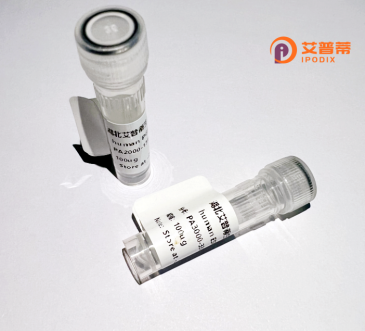
| 纯度 | >90%SDS-PAGE. |
| 种属 | Human |
| 靶点 | SUCLA2 |
| Uniprot No | Q9P2R7 |
| 内毒素 | < 0.01EU/μg |
| 表达宿主 | E.coli |
| 表达区间 | 53-463 aa |
| 活性数据 | LSLHEYMSMELLQEAGVSVPKGYVAKSPDEAYAIAKKLGSKDVVIKAQVLAGGRGKGTFESGLKGGVKIVFSPEEAKAVSSQMIGKKLFTKQTGEKGRICNQVLVCERKYPRREYYFAITMERSFQGPVLIGSSHGGVNIEDVAAESPEAIIKEPIDIEEGIKKEQALQLAQKMGFPPNIVESAAENMVKLYSLFLKYDATMIEINPMVEDSDGAVLCMDAKINFDSNSAYRQKKIFDLQDWTQEDERDKDAAKANLNYIGLDGNIGCLVNGAGLAMATMDIIKLHGGTPANFLDVGGGATVHQVTEAFKLITSDKKVLAILVNIFGGIMRCDVIAQGIVMAVKDLEIKIPVVVRLQGTRVDDAKALIADSGLKILACDDLDEAARMVVKLSEIVTLAKQAHVDVKFQLPI |
| 分子量 | 52 kDa |
| 蛋白标签 | His tag N-Terminus |
| 缓冲液 | PBS, pH7.4, containing 0.01% SKL, 1mM DTT, 5% Trehalose and Proclin300. |
| 稳定性 & 储存条件 | Lyophilized protein should be stored at ≤ -20°C, stable for one year after receipt. Reconstituted protein solution can be stored at 2-8°C for 2-7 days. Aliquots of reconstituted samples are stable at ≤ -20°C for 3 months. |
| 复溶 | Always centrifuge tubes before opening.Do not mix by vortex or pipetting. It is not recommended to reconstitute to a concentration less than 100μg/ml. Dissolve the lyophilized protein in distilled water. Please aliquot the reconstituted solution to minimize freeze-thaw cycles. |
1. **"SUCLA2 mutations cause global protein succinylation contributing to the pathomechanism of a mitochondrial encephalomyopathy"**
- **作者**: Van den Ameele et al. (2020)
- **摘要**: 揭示了SUCLA2缺陷导致线粒体三羧酸循环功能异常,并通过蛋白质广泛琥珀酰化影响细胞代谢,解释其与进行性脑肌病的关系。
2. **"Structural insights into the SUCLA2 mutations causing mitochondrial encephalomyopathy"**
- **作者**: Zhang et al. (2018)
- **摘要**: 通过重组人SUCLA2蛋白的晶体结构分析,阐明致病突变对其与β亚基结合及酶活性的影响,揭示分子机制。
3. **"Deficiency of the ADP-forming succinyl-CoA synthase activity due to SUCLA2 mutations results in encephalomyopathy"**
- **作者**: Ostergaard et al. (2007)
- **摘要**: 首次将SUCLA2基因突变与线粒体脑肌病关联,发现突变导致琥珀酰辅酶A合成酶活性和线粒体DNA缺失。
4. **"Expression and functional characterization of recombinant human SUCLA2 in a bacterial system"**
- **作者**: Chen et al. (2015)
- **摘要**: 报道重组SUCLA2蛋白的原核表达与纯化,验证其与SUCLG1亚基的相互作用及底物结合能力,为功能研究提供工具。
SUCLA2 (succinate-CoA ligase ADP-forming beta subunit) is a nuclear-encoded mitochondrial enzyme critical for the tricarboxylic acid (TCA) cycle. It forms a heterodimer with SUCLG1 (alpha subunit) to catalyze the reversible conversion of succinyl-CoA and ADP/ATP to succinate and CoA, linking energy metabolism (ATP production) with the TCA cycle. This reaction also generates substrate (succinate) for complex II of the electron transport chain.
Mutations in SUCLA2 cause mitochondrial DNA (mtDNA) depletion syndromes, primarily affecting tissues with high energy demands like the brain, muscles, and liver. Symptoms include developmental delay, dystonia, and sensorineural hearing loss. The protein’s role in maintaining mitochondrial nucleotide pools (via its association with mitochondrial nucleoside diphosphate kinase) explains its impact on mtDNA stability.
Recombinant human SUCLA2 protein, produced via heterologous expression systems (e.g., E. coli or mammalian cells), retains enzymatic activity and structural integrity. It serves as a vital tool for studying enzyme kinetics, pathological mutations, and mitochondrial disorders. Researchers use it to probe interactions with SUCLG1. assess the functional consequences of disease-linked variants, and screen potential therapeutics targeting TCA cycle deficiencies. Its production enables structural studies (e.g., X-ray crystallography) to map catalytic sites and inform drug design. Recombinant SUCLA2 also aids in developing diagnostic assays for mitochondrial diseases.
×